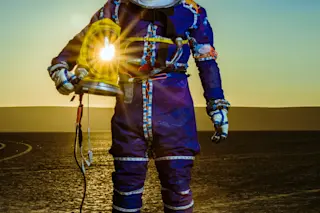Anthropologist Cameron Smith usually digs into the past, but these days, he does a lot of forward thinking. The Portland State University professor spends his spare time and money designing and building a spacesuit. He wants to make one with a price that’s about 1 percent of a comparable NASA getup, which costs roughly $70,000.
This year, he’ll put his life on the line to test his design by piloting a hot air balloon by himself to about 50,000 feet, far above the altitude of commercial jetliners.
Smith’s designs have attracted the attention of SpaceX, but the 51-year-old isn’t interested in profits. He’s committed to making his spacesuit plans freely available online. Discover joined Smith at his downtown Portland condo-and-workshop to learn more about what drives this explorer.
Q: What’s an anthropologist doing designing a spacesuit?
A: I grew up in Texas when the culture of the Apollo missions was ...















